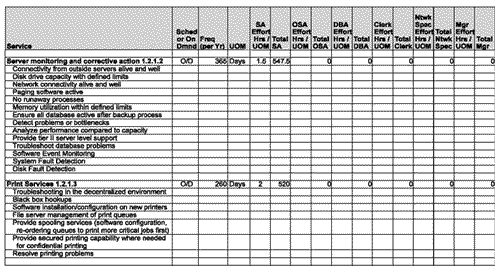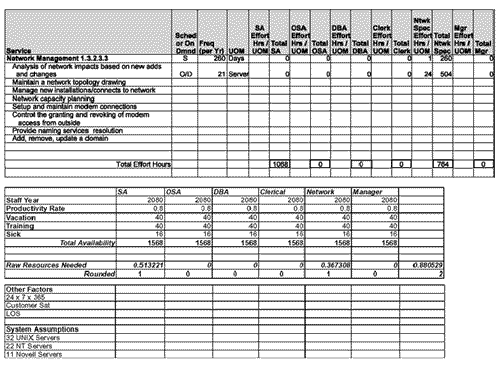5.3 DefineCommunicate the Metrics UpfrontQuality, Cost, Delivery, Value
5.3 Define/Communicate the Metrics Upfront”Quality, Cost, Delivery, Value
Setting expectations upfront in terms of QCDV should be based on specifics as much as practical and be supported by a capability to deliver on the expectations set.
5.3.1 Quality
What are the realistic expectations of quality and the range of quality that can be provided? "The 10 Elements of IT Service Quality," as identified by Gartner's D. Tunick in the September 26, 1996 Report, "Marketing the IS Organization: Questions and Answers," [3] are:
[3] D. Turick, "Marketing the IS Organization: Questions and Answers," GartnerGroup Research Note, September 26, 1996.
-
Provide basic service well.
-
Listen to your customers; understand their urgency.
-
Ensure reliability”then ensure it again.
-
Establish a service recovery and relief plan for internal customers.
-
Exceed expectations.
-
Design a service system that works for your organization.
-
Handle requests , projects, problems, and priorities fairly .
-
Reward the staff”both IS and non-IS”for coordinated effort.
-
Use IS staff members as a lightning rod for larger problems.
-
Take care of your IS employees . (Reprinted with permission”August 1999.)
Service level agreements (SLAs) are the most effective way to establish a common understanding of what expectations are and what will be delivered to meet those expectations.
An SLA should be in place before a business application is run in the production data center. It will detail the administrative services, supporting configurations (hardware and software), and supporting practices necessary to meet the application's business requirements. This agreement will be reviewed as needed, but at least annually, to ensure that it is meeting the application's business SLA requirements. At least once a year, a review process should include a customer satisfaction survey and a user satisfaction survey. Critical path interdependencies between applications will resolve to at least the same level as the application requiring the input data. Table 5-4 lists the key attributes/criteria that must be considered in the development of a service level agreement.
Table 5-4. Charting Criteria in an SLA Agreement
| Attributes/Criteria | Mission Critical (1) | Business Critical (2) | Business Efficiency (3) | User Administered (4) |
|---|---|---|---|---|
| Critical path interdependencies with other applications | Impacts identified and = 1 | Impacts identified and = < 2 | Impacts identified and = < 3 | Impacts identified and = < 4 |
| Equipment capacity usage | Overall average of ½ of available resources | Overall average of ? of available resources | Overall average of ¾ of available resources | Completed for Operational and users' needs. |
| Administrative support | Dedicated resource(s) and on site at all times | Shared on-site resource | Shared on-site resource | As available |
| Support procedures | Detailed with specific resource(s) | Detailed with shared resource(s) | Detailed with shared resource(s) | Detailed but done as resource available |
| Documentation | Completed for Operational and users' needs | Completed for Operational and users' needs | Completed for Operational and users' needs | Completed for Operational needs |
| Training | Completed for users and support staff before putting into production | Completed for users and support staff before putting into production | At least one on- site support staff trained on operational needs | At least one on- site support staff trained on operational needs |
| Approved "Move to Production" Plan | Complete testing plan (to include "live" dress rehearsals for one reporting cycle) | Complete testing plan (to include "live" dress rehearsals for one reporting cycle) | Complete testing plan (to include "live" dress rehearsals for one week) | Complete testing plan (to include "live" dress rehearsals for one week) |
| Hardware | Only proven production HW | Only proven production HW | Can use HW not used in production but has been used by user for > 6 mos. | Can use HW not used in production but has been used by user for > 3 mos. |
| Software (i.e., OS, DBMS, Utilities, etc.) | Only proven production SW | Only proven production SW | Can use SW not used in production but has been used by user for > 6 mos. | Can use SW not used in production but has been used by user for > 3 mos. |
| Application access control security | Highest | High | Medium | Medium |
| Data loss | None | None | No more than one business day's work lost | No more than one business day's work lost |
| Disaster recovery | Immediate | ASAP | When possible | None |
| SLA review | As change demands but at least annually | As change demands but at least annually | At least annually | At least annually |
| SLA reporting | Real-time on production issues and periodic per contract | Real-time on production issues and periodic per contract | Periodic per contract | Periodic per contract |
| Escalation support | Detailed and crisis team handles | Detailed, crisis team called in when necessary | Detailed | Only essentials documented |
| Security Audits | Scheduled and unannounced | Scheduled and unannounced | Scheduled and unannounced | Scheduled and unannounced |
5.3.2 Cost
Identifying, allocating, and charging for services is a critical element in the overall communication package. Much like the commentary on determining value in an earlier section, the resources applied to identifying, capturing, and allocating cost may take more resource investments than are warranted, especially , if the granularity expected is very fine.
Table 5-5 is an example of a straightforward approach used to identify the staffing component of cost.
Other factors, such as hours of operation (24 7 365) and help desk and system response time (level of service) must be taken into consideration when developing the service model. Once the number of hours required is determined for each service, a standard loaded cost-per-resource type can be applied to determine the staffing cost.
Staffing costs can then be added to infrastructure costs such as hardware, software, network, maintenance, and facilities to arrive at a total cost of services.
The cost of services must be identified as early as possible, factored into the pricing equation, and communicated to users. This will ensure that they have the opportunity to commit appropriate funding for the services they require to support their business processes.
5.3.3 Delivery
Users must understand how to receive the services they desire and what level of responsiveness should be expected. A central source to initiate request for services is necessary to ensure that all requests are recorded, responded to by the appropriate service provider, and tracked to completion. In the service model defined in this book, the call center is that central receiver of service requests.
In addition to a physically staffed call center, an on-line capability that allows users to request services via an internal Website can reduce the amount of resource required to staff the call center and provide direct access on-line. The service menu described earlier should describe the availability of the service”whether it is available on a 7 24 365 basis, or only during business hours five days a week”and how to expect it to be delivered.
Table 5.5. Service and Associated Cost Model
| |
| |
The status of the service to be delivered should be communicated to the user promptly and regularly until it has been completed. The status may be in the form of e-mails, voice mails , intranet sites, or phone calls.
5.3.4 Value
Value is measured from the perspective of the user's capability to satisfy their customers needs. Measuring value from a traditional ROI standpoint, as addressed in an earlier section, usually does not generate a positive ROI itself when the effort required to produce it is fully considered.
The perception of the user is the most important factor in determining whether value was created or not. Operational statistics such as uptime, response time, and turnarounds are fine for managing IT, but usually don't reflect whether the user received meaningful value.
Assessing how happy the user is with the services received is a major determinant of perceived value. This assessment can be as simple as an e-mail attachment that has a "smiley face," "frowney face," or "so-so face" to respond to the service received. Or, the assessment may be a multipage professionally engineered survey form sent to random users on a regular basis. In addition to the surveys, one-on-one interviews and analysis of help desk calls can be valuable tools to assess the value users perceive they are receiving from their integrated services that are delivered.
Regularly publishing the responses to the surveys will be a motivating force for the suppliers of the services to continually strive for improvement, acknowledge that users' views of what is valuable is important, and help determine which services are in need of rework or elimination .
EAN: 2147483647
Pages: 93

